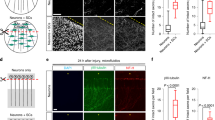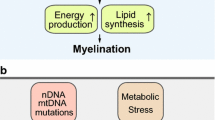Abstract
Axons are long slender portions of neurons that transmit electrical impulses to maintain proper physiological functioning. Axons in the central nervous system (CNS) and peripheral nervous system (PNS) do not exist in isolation but are found to form a complex association with their surrounding glial cells, oligodendrocytes and Schwann cells. These cells not only myelinate them for faster nerve impulse conduction but are also known to provide metabolic support. Due to their incredible length, continuous growth, and distance from the cell body (where major energy synthesis takes place), axons are in high energetic demand. The stability and integrity of axons have long been associated with axonal energy levels. The current mini-review is thus focused on how axons accomplish their high energetic requirement in a cell-autonomous manner and how the surrounding glial cells help them in maintaining their integrity by fulfilling their energy demands (non-cell autonomous trophic support). The concept that adjacent glial cells (oligodendrocytes and Schwann cells) provide trophic support to axons and assist them in maintaining their integrity comes from the conditional knockout research and the studies in which the metabolic pathways controlling metabolism in these glial cells are modulated and its effect on axonal integrity is evaluated. In the later part of the mini-review, the current knowledge of axon-glial metabolic coupling during various neurodegenerative conditions was discussed, along with the potential lacunae in our current understanding of axon-glial metabolic coupling.



Similar content being viewed by others
Data Availability
Not applicable.
References
MacVicar BA, Wicki-Stordeur L, Bernier L-P (2017) The cost of communication in the brain. eLife 6:e27894. https://doi.org/10.7554/eLife.27894
(2015) ATP made by mitochondria diffuse in nerve cells to maintain energy levels for synaptic transmission(♦): the role of mitochondrially derived ATP in synaptic vesicle recycling. J Biol Chem 290 (37):22337. https://doi.org/10.1074/jbc.P115.656405
Chamberlain KA, Sheng ZH (2019) Mechanisms for the maintenance and regulation of axonal energy supply 97(8):897-913.https://doi.org/10.1002/jnr.24411
Smith GM, Gallo G (2018) The role of mitochondria in axon development and regeneration 78(3):221-237.https://doi.org/10.1002/dneu.22546
Magistretti PJ, Allaman I (2015) A cellular perspective on brain energy metabolism and functional imaging. Neuron 86(4):883–901. https://doi.org/10.1016/j.neuron.2015.03.035
Yang S, Park JH, Lu H-C (2023) Axonal energy metabolism, and the effects in aging and neurodegenerative diseases. Mol Neurodegener 18(1):49. https://doi.org/10.1186/s13024-023-00634-3
Yang J, Wu Z, Renier N, Simon DJ, Uryu K, Park DS, Greer PA, Tournier C et al (2015) Pathological axonal death through a MAPK cascade that triggers a local energy deficit. Cell 160(1–2):161–176. https://doi.org/10.1016/j.cell.2014.11.053
Han Q, **e Y, Ordaz JD, Huh AJ, Huang N, Wu W, Liu N, Chamberlain KA et al (2020) Restoring cellular energetics promotes axonal regeneration and functional recovery after spinal cord injury. Cell Metab 31(3):623-641.e628. https://doi.org/10.1016/j.cmet.2020.02.002
Jäkel S, Dimou L (2017) Glial cells and their function in the adult brain: a journey through the history of their ablation. Front Cell Neurosci 11(24). https://doi.org/10.3389/fncel.2017.00024
Salzer JL, Zalc B (2016) Myelination. Curr Biol 26(20):R971–R975. https://doi.org/10.1016/j.cub.2016.07.074
Stassart RM, Möbius W, Nave K-A, Edgar JM (2018) The axon-myelin unit in development and degenerative disease. Front Neurosci 12(467). https://doi.org/10.3389/fnins.2018.00467
Koepsell H (2020) Glucose transporters in brain in health and disease. Pflugers Arch 472(9):1299–1343. https://doi.org/10.1007/s00424-020-02441-x
Dienel GA (2019) Brain glucose metabolism: integration of energetics with function. Physiol Rev 99(1):949–1045. https://doi.org/10.1152/physrev.00062.2017
McCommis KS, Finck BN (2015) Mitochondrial pyruvate transport: a historical perspective and future research directions. Biochem J 466(3):443–454. https://doi.org/10.1042/bj20141171
Mishkovsky M, Comment A, Gruetter R (2012) In vivo detection of brain Krebs cycle intermediate by hyperpolarized magnetic resonance. J Cereb Blood Flow Metab: Off J Int Soc Cereb Blood Flow Metab 32(12):2108–2113. https://doi.org/10.1038/jcbfm.2012.136
Yellen G (2018) Fueling thought: management of glycolysis and oxidative phosphorylation in neuronal metabolism. J Cell Biol 217(7):2235–2246. https://doi.org/10.1083/jcb.201803152
Rogatzki MJ, Ferguson BS, Goodwin ML, Gladden LB (2015) Lactate is always the end product of glycolysis. Front Neurosci 9(22). https://doi.org/10.3389/fnins.2015.00022
Jensen NJ, Wodschow HZ, Nilsson M, Rungby J (2020) Effects of ketone bodies on brain metabolism and function in neurodegenerative diseases. 21(22). https://doi.org/10.3390/ijms21228767
Cardanho-Ramos C, Morais VA (2021) Mitochondrial biogenesis in neurons: how and where. 22(23). https://doi.org/10.3390/ijms222313059
Quintero H, Shiga Y, Belforte N, Alarcon-Martinez L, El Hajji S, Villafranca-Baughman D, Dotigny F, Di Polo A (2022) Restoration of mitochondria axonal transport by adaptor Disc1 supplementation prevents neurodegeneration and rescues visual function. Cell Rep 40(11):111324. https://doi.org/10.1016/j.celrep.2022.111324
Buscham TJ, Eichel-Vogel MA, Steyer AM, Jahn O (2022) Progressive axonopathy when oligodendrocytes lack the myelin protein CMTM5. 11. https://doi.org/10.7554/eLife.75523
Edgar JM, McLaughlin M, Werner HB, McCulloch MC, Barrie JA, Brown A, Faichney AB, Snaidero N, Nave KA, Griffiths IR (2009) Early ultrastructural defects of axons and axon-glia junctions in mice lacking expression of Cnp1. Glia 57(16):1815–1824. https://doi.org/10.1002/glia.20893
Yin X, Kidd GJ (2016) Proteolipid protein-deficient myelin promotes axonal mitochondrial dysfunction via altered metabolic coupling. 215(4):531-542
Meyer N, Richter N, Fan Z, Siemonsmeier G, Pivneva T, Jordan P, Steinhäuser C, Semtner M et al (2018) Oligodendrocytes in the mouse corpus callosum maintain axonal function by delivery of glucose. Cell Rep 22(9):2383–2394. https://doi.org/10.1016/j.celrep.2018.02.022
Saab AS, Tzvetavona ID, Trevisiol A, Baltan S, Dibaj P, Kusch K, Möbius W, Goetze B et al (2016) Oligodendroglial NMDA receptors regulate glucose import and axonal energy metabolism. Neuron 91(1):119–132. https://doi.org/10.1016/j.neuron.2016.05.016
Jha MK, Morrison BM (2020) Lactate transporters mediate glia-neuron metabolic crosstalk in homeostasis and disease. Front Cell Neurosci 14. https://doi.org/10.3389/fncel.2020.589582
Philips T, Mironova YA, Jouroukhin Y, Chew J, Vidensky S, Farah MH, Pletnikov MV, Bergles DE et al (2021) MCT1 deletion in oligodendrocyte lineage cells causes late-onset hypomyelination and axonal degeneration. Cell Rep 34(2):108610. https://doi.org/10.1016/j.celrep.2020.108610
Lee Y, Morrison BM, Li Y, Lengacher S, Farah MH, Hoffman PN, Liu Y, Tsingalia A et al (2012) Oligodendroglia metabolically support axons and contribute to neurodegeneration. Nature 487(7408):443–448. https://doi.org/10.1038/nature11314
Fünfschilling U, Supplie LM, Mahad D, Boretius S, Saab AS, Edgar J, Brinkmann BG, Kassmann CM et al (2012) Glycolytic oligodendrocytes maintain myelin and long-term axonal integrity. Nature 485(7399):517–521. https://doi.org/10.1038/nature11007
Pérez-Escuredo J, Van Hée VF, Sboarina M, Falces J, Payen VL, Pellerin L (1863) Sonveaux P (2016) Monocarboxylate transporters in the brain and in cancer. Biochem Biophys Acta 10:2481–2497. https://doi.org/10.1016/j.bbamcr.2016.03.013
Yang H, Shan W, Zhu F, Wu J, Wang Q (2019) Ketone bodies in neurological diseases: focus on neuroprotection and underlying mechanisms. Front Neurol 10:585. https://doi.org/10.3389/fneur.2019.00585
Krämer-Albers EM, Bretz N, Tenzer S, Winterstein C, Möbius W, Berger H, Nave KA, Schild H et al (2007) Oligodendrocytes secrete exosomes containing major myelin and stress-protective proteins: trophic support for axons? Proteomics Clin Appl 1(11):1446–1461. https://doi.org/10.1002/prca.200700522
Holm MM, Kaiser J, Schwab ME (2018) Extracellular vesicles: multimodal envoys in neural maintenance and repair. Trends Neurosci 41(6):360–372. https://doi.org/10.1016/j.tins.2018.03.006
Frühbeis C, Kuo-Elsner WP (2020) Oligodendrocytes support axonal transport and maintenance via exosome secretion. 18(12):e3000621. https://doi.org/10.1371/journal.pbio.3000621
Mukherjee C, Kling T, Russo B, Miebach K, Kess E, Schifferer M, Pedro LD, Weikert U et al (2020) Oligodendrocytes provide antioxidant defense function for neurons by secreting ferritin heavy chain. Cell Metab 32(2):259-272.e210. https://doi.org/10.1016/j.cmet.2020.05.019
Licht-Mayer S, Campbell GR, Canizares M, Mehta AR, Gane AB, McGill K, Ghosh A, Fullerton A et al (2020) Enhanced axonal response of mitochondria to demyelination offers neuroprotection: implications for multiple sclerosis. Acta Neuropathol 140(2):143–167. https://doi.org/10.1007/s00401-020-02179-x
Mietto BS, Jhelum P, Schulz K, David S (2021) Schwann cells provide iron to axonal mitochondria and its role in nerve regeneration. J Neurosci: Off J Soc Neurosci 41(34):7300–7313. https://doi.org/10.1523/jneurosci.0900-21.2021
Huang E, Li S (2022) Liver kinase B1 functions as a regulator for neural development and a therapeutic target for neural repair. 11(18). https://doi.org/10.3390/cells11182861
Beirowski B, Babetto E, Golden JP, Chen YJ, Yang K (2014) Metabolic regulator LKB1 is crucial for Schwann cell-mediated axon maintenance. 17(10):1351–1361. https://doi.org/10.1038/nn.3809
Deleyto-Seldas N, Efeyan A (2021) The mTOR–autophagy axis and the control of metabolism. Front Cell Dev Biol 9(1519). https://doi.org/10.3389/fcell.2021.655731
Babetto E, Wong KM, Beirowski B (2020) A glycolytic shift in Schwann cells supports injured axons. 23(10):1215-1228.https://doi.org/10.1038/s41593-020-0689-4
Viader A, Sasaki Y, Kim S, Strickland A, Workman CS, Yang K, Gross RW, Milbrandt J (2013) Aberrant Schwann cell lipid metabolism linked to mitochondrial deficits leads to axon degeneration and neuropathy. Neuron 77(5):886–898. https://doi.org/10.1016/j.neuron.2013.01.012
Kim S, Maynard JC (2016) Schwann cell O-GlcNAc glycosylation is required for myelin maintenance and axon integrity. 36(37):9633-9646.https://doi.org/10.1523/jneurosci.1235-16.2016
Wang W, Zhao F, Ma X, Perry G, Zhu X (2020) Mitochondria dysfunction in the pathogenesis of Alzheimer’s disease: recent advances. 15(1):30.https://doi.org/10.1186/s13024-020-00376-6
Mot AI, Depp C, Nave KA (2018) An emerging role of dysfunctional axon-oligodendrocyte coupling in neurodegenerative diseases. Dialogues Clin Neurosci 20(4):283–292
Salvadores N, Sanhueza M, Manque P, Court FA (2017) Axonal degeneration during aging and its functional role in neurodegenerative disorders. Front Neurosci 11(451). https://doi.org/10.3389/fnins.2017.00451
Hagemeyer N, Goebbels S, Papiol S, Kästner A, Hofer S, Begemann M, Gerwig UC, Boretius S et al (2012) A myelin gene causative of a catatonia-depression syndrome upon aging. EMBO Mol Med 4(6):528–539. https://doi.org/10.1002/emmm.201200230
Saito ER, Miller JB, Harari O, Cruchaga C, Mihindukulasuriya KA, Kauwe JSK, Bikman BT (2021) Alzheimer’s disease alters oligodendrocytic glycolytic and ketolytic gene expression. Alzheimers Dement: J Alzheimers Assoc. https://doi.org/10.1002/alz.12310
Chu TH, Cummins K, Sparling JS, Tsutsui S, Brideau C, Nilsson KPR, Joseph JT, Stys PK (2017) Axonal and myelinic pathology in 5xFAD Alzheimer’s mouse spinal cord. 12(11):e0188218. https://doi.org/10.1371/journal.pone.0188218
Stieber A, Gonatas JO, Gonatas NK (2000) Aggregates of mutant protein appear progressively in dendrites, in periaxonal processes of oligodendrocytes, and in neuronal and astrocytic perikarya of mice expressing the SOD1(G93A) mutation of familial amyotrophic lateral sclerosis. J Neurol Sci 177(2):114–123. https://doi.org/10.1016/s0022-510x(00)00351-8
Bouçanova F, Chrast R (2020) Metabolic interaction between Schwann cells and axons under physiological and disease conditions. Front Cell Neurosci 14:148. https://doi.org/10.3389/fncel.2020.00148
Philips T, Rothstein JD (2017) Oligodendroglia: metabolic supporters of neurons. J Clin Investig 127(9):3271–3280. https://doi.org/10.1172/jci90610
Stassart RM, Fledrich R, Velanac V, Brinkmann BG, Schwab MH, Meijer D, Sereda MW, Nave KA (2013) A role for Schwann cell-derived neuregulin-1 in remyelination. Nat Neurosci 16(1):48–54. https://doi.org/10.1038/nn.3281
Guertin AD, Zhang DP, Mak KS, Alberta JA, Kim HA (2005) Microanatomy of axon/glial signaling during Wallerian degeneration. J Neurosci: Off J Soc Neurosci 25(13):3478–3487. https://doi.org/10.1523/jneurosci.3766-04.2005
Acknowledgements
The authors acknowledge Dr. Bogdan Beirowski, Associate Professor, Department of Neurology, Ohio State University, Wexner Medical Center, USA, for providing his valuable guidance and suggestions while preparation of this manuscript.
Funding
The authors declare that no funds or grants or any other support were received during the preparation of this manuscript.
Author information
Authors and Affiliations
Contributions
Sandeep K. Mishra came up with the idea and is involved in the majority of manuscript writing. Sandip Prasad Tiwari contributed in writing few topics and addition of figures to the manuscript.
Corresponding author
Ethics declarations
Ethics Approval
Not applicable.
Consent to Participate
Not applicable.
Consent for Publication
Not applicable.
Competing Interests
The authors declare no competing interests.
Additional information
Publisher's Note
Springer Nature remains neutral with regard to jurisdictional claims in published maps and institutional affiliations.
Rights and permissions
Springer Nature or its licensor (e.g. a society or other partner) holds exclusive rights to this article under a publishing agreement with the author(s) or other rightsholder(s); author self-archiving of the accepted manuscript version of this article is solely governed by the terms of such publishing agreement and applicable law.
About this article
Cite this article
Mishra, S.K., Tiwari, S.P. Bioenergetics of Axon Integrity and Its Regulation by Oligodendrocytes and Schwann Cells. Mol Neurobiol (2024). https://doi.org/10.1007/s12035-024-03950-x
Received:
Accepted:
Published:
DOI: https://doi.org/10.1007/s12035-024-03950-x




